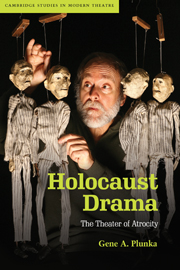Book contents
- Frontmatter
- Contents
- Acknowledgments
- 1 Introduction
- 2 Staging the Banality of Evil
- 3 Culture and the Holocaust
- 4 The Holocaust as Literature of the Body
- 5 Transcending the Holocaust
- 6 Marxism and the Holocaust
- 7 Aryan Responsibility During the Holocaust, I
- 8 Aryan Responsibility During the Holocaust, II
- 9 Heroism and Moral Responsibility in the Ghettoes
- 10 Dignity in the Concentration Camps
- 11 Holocaust Survivors in the United States and Israel
- 12 The Survivor Syndrome and the Effects of the Holocaust on Survivor Families
- 13 Holocaust Survivor Memory
- 14 The Holocaust and Collective Memory
- Notes
- Bibliography
- Index
3 - Culture and the Holocaust
Published online by Cambridge University Press: 01 July 2009
- Frontmatter
- Contents
- Acknowledgments
- 1 Introduction
- 2 Staging the Banality of Evil
- 3 Culture and the Holocaust
- 4 The Holocaust as Literature of the Body
- 5 Transcending the Holocaust
- 6 Marxism and the Holocaust
- 7 Aryan Responsibility During the Holocaust, I
- 8 Aryan Responsibility During the Holocaust, II
- 9 Heroism and Moral Responsibility in the Ghettoes
- 10 Dignity in the Concentration Camps
- 11 Holocaust Survivors in the United States and Israel
- 12 The Survivor Syndrome and the Effects of the Holocaust on Survivor Families
- 13 Holocaust Survivor Memory
- 14 The Holocaust and Collective Memory
- Notes
- Bibliography
- Index
Summary
On 29 September 1933, the Nazis created the Reich Chamber of Culture, which forbade Jews from participating in all cultural activities, including theater, motion pictures, journalism, art, and literature. Jews were thus dismissed from all positions that they held in cultural spheres. Nevertheless, despite the Nuremberg laws that deprived Jews of German citizenship, Martin Buber in 1936 encouraged Jews to assume a renewed interest in their own cultural activities. Jews formed the Kulturbund, which provided employment for thousands of actors and musicians disallowed from performing on German stages. In writing about the Kulturbund, Holocaust historian Lucy S. Dawidowicz states, “In the first years of its existence, about 8,500 presentations were offered–operas, plays, concerts (orchestra, chamber music, choir, and soloists), lectures, recitations, cabaret performances, ballets, film showings, and art exhibits.”
When the Nazis herded Jews into the ghettoes of eastern Europe, culture became paramount. Although Jews were forbidden to perform works by Aryan composers and writers, they compensated in other ways. Art became an important medium for the release of the imagination, as well as a means of defying the Nazis. Hundreds of songs were written, many from Yiddish folklore, to boost morale. Sidra DeKoven Ezrahi reports that underground organizations produced numerous literary manuscripts and performed skits that adapted biblical themes to the suffering of the Jews under Nazi rule.
- Type
- Chapter
- Information
- Holocaust DramaThe Theater of Atrocity, pp. 50 - 70Publisher: Cambridge University PressPrint publication year: 2009

